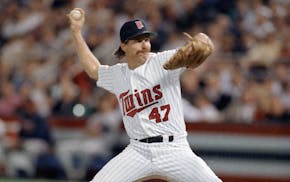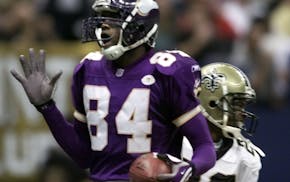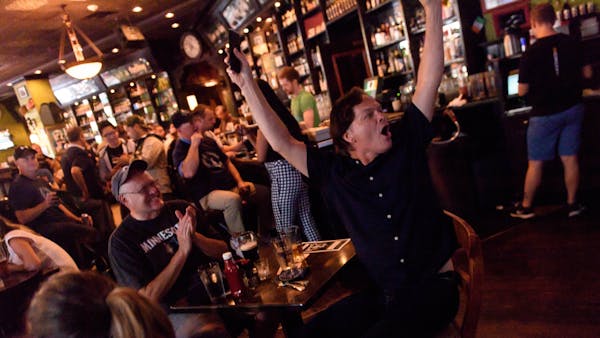Timberwolves coach Tom Thibodeau told me earlier this week that there were a lot of possibilities during Thursday night's NBA draft. That proved to be true after the Wolves made one of the biggest acquisitions in team history by trading the No. 7 pick and guards Kris Dunn and Zach LaVine to the Chicago Bulls for All-Star guard Jimmy Butler and the No. 16 pick.
The Wolves selected Arizona forward Lauri Markkanen for the Bulls at No. 7, and the Bulls took 6-11 Creighton center Justin Patton for the Wolves at No. 16.
Patton is a high-upside player, a lanky, efficient center who can run and will have a chance to play alongside center Karl-Anthony Towns.
But make no mistake, this had to be a hard decision for the Wolves.
I'm most surprised to see them move on from LaVine, one of the team's most dynamic and explosive scorers, who averaged 18.9 points, 3.4 rebounds and 3.0 assists last season before tearing his left ACL.
It was also telling to see Thibodeau trade Dunn — last year's No. 5 pick, and a player who seemed to be hand-picked as Ricky Rubio's eventual replacement — and seemingly embrace Rubio as the franchise's point guard.
Rubio had long been rumored as a trade possibility, but his improved shooting toward the end of last season and his ability to make his teammates better every second he's on the floor must have swayed the front office.
Still, this trade was about acquiring Butler. The Wolves will send out a lineup that features Butler, Towns and guard/forward Andrew Wiggins, three players who can dominate on any given night.
Butler averaged career highs with 23.9 points, 6.2 rebounds, 5.5 assists and 1.9 steals per game last season, but he has put up similar numbers for the past three years.
Butler played his first four NBA seasons under Thibodeau, and while Butler has three years and $55.9 million left on his contract, with a player option in the third year, the Wolves hope he'll be part of their long-term plans.
He was an Olympic gold medalist with the American team in Rio de Janeiro in 2016, was named the NBA Most Improved Player in 2015, has made three NBA All-Defensive Teams and was named to the All-NBA third team this season.
The Wolves just made it clear they're no longer going to settle on potential. The front office wants to win and win now.
Different history
The NBA draft these days is viewed as a time for teams to try to pick the next franchise-changing star. When I was making the draft picks for the Minneapolis Lakers from the 1947-48 season until 1956-57, and for the Chicago Packers (later Zephyrs) expansion team in the early 1960s, there were numerous other considerations to be made.
During that era, the league had what was called the territorial draft. The NBA didn't draw large crowds as it does today, so the league wanted to try to keep college stars near their universities or hometowns so fans would continue to follow them and attend pro games.
This meant certain franchises were given a huge boost by having the first rights to some big-name players.
While I was with the Lakers, we brought in players such as Vern Mikkelsen, who played at Hamline University and was selected in the 1949 territorial draft. To think that Mikkelsen, an All-America in the NAIA and future NBA Hall of Famer, would be available only to a local team is the kind of situation today's league would never allow.
Following Mikkelsen as Lakers territorial picks were two Gophers All-Americas, Whitey Skoog in 1951 and Dick Garmaker in 1955.
It didn't stop there, because we always were looking to bring local talent to the team. We drafted Jim Fritsche out of Hamline with the seventh overall pick in the 1953 draft and Gophers forward Ed Kalafat with the ninth overall pick in the 1954 draft. A year later we grabbed Chuck Mencel, also of the Gophers, with the 12th overall pick in 1955 — which at that time was a second-round pick.
Yes, at that time it wasn't simply about selecting the best player. The NBA needed ticket revenue, and drafting local players was a huge first step. They also helped establish the Lakers as the league's first dynasty.
Lovellette stolen
One of the greatest picks I made in my time with the Lakers was in 1952. We were coming off a 40-26 season, one game out of first place in the Western Division, and then went on to win the NBA Finals over the New York Knicks in seven games, with the clincher coming at home.
We had George Mikan on the All-NBA first team and Mikkelsen and Jim Pollard on the second team. After winning the title, we had the last pick in the first round at No. 9 overall.
The hottest player in college basketball at that time was Clyde Lovellette, a 6-9 center and two-time All-America for Kansas. He remains the only player in NCAA history to lead the nation in scoring and win a national title in the same season (1951-52).
But the story was that Lovellette was going to play with the Phillips 66ers, an AAU team that traveled all over the country. And because of that deal, no other team drafted him because the word was he wouldn't sign a contract.
When we selected Lovellette, the room erupted and the draft was brought to a halt. No one thought we had any right to pick a player that good, especially after winning the title.
The league stopped the meeting and asked the NBA lawyers if they could stop the selection. It was the most controversial draft pick up to that time.
But there was no rule against the pick. And while Lovellette didn't join the team until after a year with the 66ers, he made a huge impact. He averaged 17.2 points and 11.2 rebounds in four seasons with the Lakers and helped us win our fourth title in 1954.
Barriers broken
While the draft today is a much bigger production, I was there for perhaps the most important draft pick in NBA history.
That was in 1950 when Celtics owner Walter A. Brown and coach Red Auerbach drafted forward Chuck Cooper of Duquesne at No. 12 overall, making him the first black player drafted by the NBA.
The league at that time had a special relationship with black players because Abe Saperstein, who ran the Harlem Globetrotters, had a monopoly on selecting black players out of college to play for him.
The long-held threat from Saperstein was that if anyone drafted a black player, he would cancel all Globetrotter games against NBA teams, and those contests were some of the biggest moneymakers in basketball at that time. When Brown and Auerbach made that pick, it caused another delay in the draft room because most of the clubs couldn't afford to lose booking the Globetrotters.
Saperstein held to his word and canceled all games with NBA teams that season, but the color barrier was finally broken in the league.
Sid Hartman can be heard on WCCO AM-830 at 8:40 a.m. on Monday and Friday and at 9:30 a.m. on Sunday. E-mail: shartman@startribune.com

Sid Instant Replay from 1977: Vikings' Super Bowl loss to Raiders hurt the most

Read Sid's column from 1974, when Ara Parseghian left Notre Dame

Sid instant replay: No greater hero than Twins' Morris in World Series


